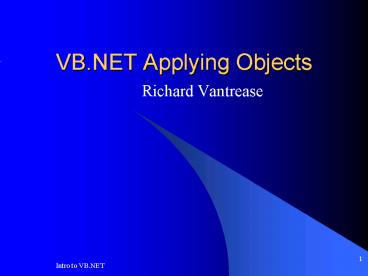VB'NET Applying Objects - PowerPoint PPT Presentation
1 / 13
Title:
VB'NET Applying Objects
Description:
Called method must have same method signature. Slower than early binding. ... Child class provides expected method signature. Intro to VB.NET. 11. Inheritance ... – PowerPoint PPT presentation
Number of Views:62
Avg rating:3.0/5.0
Title: VB'NET Applying Objects
1
VB.NET Applying Objects
- Richard Vantrease
2
Introduction
- Using VB.NET to create application objects
through polymorphism and inheritance.
3
Agenda
- Encapsulation
- Polymorphism
- Inheritance
4
Encapsulation
- Separating interface from implementation.
- Creating a black box so that developers do not
know or care about the implementation, just the
interface.
5
Polymorphism
- Late Binding
- Multiple Interfaces
- .NET Reflection
- .NET Reflection Multiple Interfaces
- Polymorphism with Inheritance
6
Late Binding
- Object variable is declared without a specific
type, just uses Object type. - Cannot be used with Option Strict. Option must
be turned off in the module file. - Called method must have same method signature.
- Slower than early binding.
- Errors might be missed until run-time.
7
Multiple Interfaces
- Object variable is declared with using a specific
type. - Known as strongly typed.
- Interface is known by compiler which helps the
IDE catch errors sooner. - Faster than late binding.
- Use with caution and document well as it may
cause confusion.
8
.NET Reflection
- Interrogates .NET external assembly at run-time
to determine its classes and interfaces. - Automatically used by Late Binding technique.
- Similar to Late Binding in that interface is not
really available until compile time.
9
.Net Reflection Multiple Interfaces
- Adds strong typing to .NET Reflection.
- Allows the interface to be known even if the
external assembly is not.
10
Polymorphism with Inheritance
- Another form of polymorphism.
- Child class provides expected method signature.
11
Inheritance
- Base class is created to define the common
interface and functionality. - Child class inherits part of its interface and
functionality and then extends it to meet the
needs of its object. - It is possible to use multiple inheritance where
a child class inherits from more than one base
class.
12
Framework
- Base classes that are not specific to any
application, but provide base/common
functionality only.
13
Summary
- While powerful Polymorphism and Inheritance must
be used carefully and with caution. Can cause
confusion, or might limit later development.































